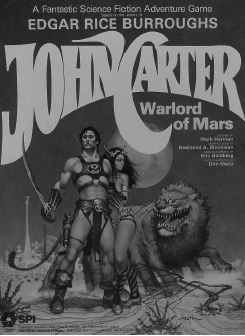 J is for ... John Carter
J is for ... John CarterJohn Carter, Warlord of Mars
SPI (1979, $20.00)Designed by Mark Herman and Eric Goldberg
Players 2 to 6
Playing Time 1 to 6 hours
Period Sci-Fi
Scale Tactical / strategic
Components
1 SPI bookcase box1 22”x34” unmounted mapsheet
1 28 page rulebook
400 die-cut counters
169 die-cut cards
1 16 page background booklet
2 8 page Charts & Tables booklets
1 errata sheet
1 each six-sided die & twenty-sided die
1 plastic counter tray with lid
Counter Manifest
400 142 red; 62 khaki; 43 gray; 43 blue; 23 orange; 22 dark green; 15 light green; 15 pink; 14 yellow; 13 dark khaki; 8 white.Card Manifest
168 numbered cards (detailed on page 5 of the rulebook)1 card with the game title
SPI says
“John Carter, Warlord of Mars relentlessly searches for his mate, the incomparable Dejah Thoris, across the hostile Martian surface, pursuing the dastardly villain who has abducted her and fled to a distant city. John Carter must fight his way through monsters and men to rescue Dejah Thoris from the evil designs of her captor. The city contains numerous hiding places and secret passages from which our hero must ferret out the prize. Playing cards for Random Events, Movement, Acquisition, and Maneuver both hinder and help him as he continues his valiant quest. Simple probability charts determine the outcome of each exciting twist of events in the game.”The reviewers say
“While SPI has been guilty, in some cases, of turning out ‘cookie-cutter’ game systems, this is not the case with John Carter. It would have been relatively easy to follow the path of their previous fantasy games and do JC along the lines of War of the Rings or Swords and Sorcery. But, they didn’t. They chose a new, and I might add successful, path ... It is a fun, exciting, and unique game.” Dale Okada in Campaign 94.“The game is divided into three games ... The Dueling Game is a section of rules dealing exclusively with hand-to-hand combat ... The Strategic Game builds upon the Dueling Game, providing the framework for encounters and combats ... During a game, a player plays both a hero character and a villain corresponding to his opponent’s hero ... The emphasis of a player’s involvement is on his hero, his villain being merely a way to foil the opponent’s hero ... The Military Game utilizes the strategic map ... The units used represent fleet strength points, done in different colors for each of the city-states ... Overall, John Carter, Warlord of Mars is an interesting game, and remarkably true to its sources ... This is not to say that the game is flawless. The game is so true to the books that it accurately duplicates some of their faults as well. This is mainly found in the Dueling Game, where the frequent combats tend to get a bit repetitious ... Players who are interested in the game as a way of participating in the adventures on Barsoom will be able to overlook these points and fully enjoy the game.” Tony Watson in The Dragon 42.
“A villain has captured the fair love of the protagonist and must be given his just deserts by the hero. The distressed damsel must be rescued before she is subjected to ‘unspeakable acts’ (think about it) at the hands of the villain and/or his henchmen ... For the first time in the history of the hobby, a game has been built around themes such as love, romance, treachery, remorse, hatred and friendship.” Rated ‘Excellent’ by David Ritchie in Ares 1.
Comments
An interesting hyrbid game system -- the odd, chart-heavy mechanics seem to have more in common with role-playing games while the physical execution of the game is clearly wargame-based. John Carter, Warlord of Mars was inspired by the Barsoomian novels written by Edgar Rice Burroughs (who also created Tarzan). These science fiction/fantasy novels were set on the planet Mars (Barsoom to its fantastic inhabitants). The fun factor for Burroughs fans is indeed high, as demonstrated by random event cards such as: Villain Attempts to Besmirch Fair Princess’ Honor, Secret Curtain Opens and Princess Disappears, Slug Turnkey and Escape, Mad Scientist Saves Hero Then Uses Him For Experiment, etc.Collector’s Value
For current buyers, the attraction would seem to stem from either the Burroughs connection or SPI name. Today’s gamers are likely to be turned off by the maze of charts which make John Carter look like something that should be run on a computer. Boone lists low/high/average prices of $10/$103/$34.84 at auction and $10/$60/$29.29 for sale.Other games by these designers
Goldberg: Commando; Descent on Crete; DragonQuest; Kursk II (all SPI), Tales of the Arabian Nights (West End).Herman: GBoH series; For the People; We the People (Avalon Hill); Across Suez; Battle for Jerusalem; Bundeswehr; First World War; Mech War 2; The Next War; October War; Raid!; RDF; Red Sun Rising; The Siege of Tyre; Stonewall (all SPI); Aegean Strike; Central America; Flashpoint Golan; France ’44; Gulf Strike; Pacific War; The Peloponnesian War (all Victory).
Back to Simulacrum Vol. 4 No. 2 Table of Contents
Back to Simulacrum List of Issues
Back to MagWeb Master Magazine List
© Copyright 2002 by Steambubble Graphics
This article appears in MagWeb (Magazine Web) on the Internet World Wide Web. Other military history articles and gaming articles are available at http://www.magweb.com